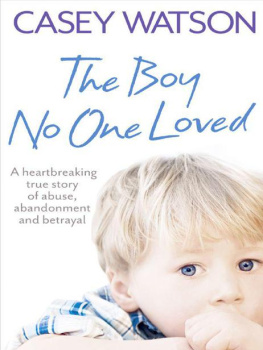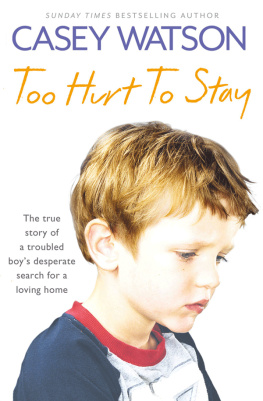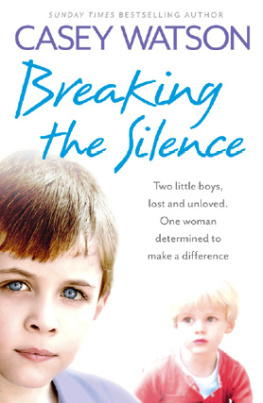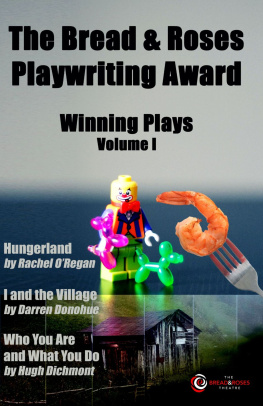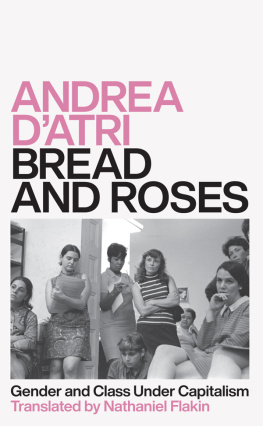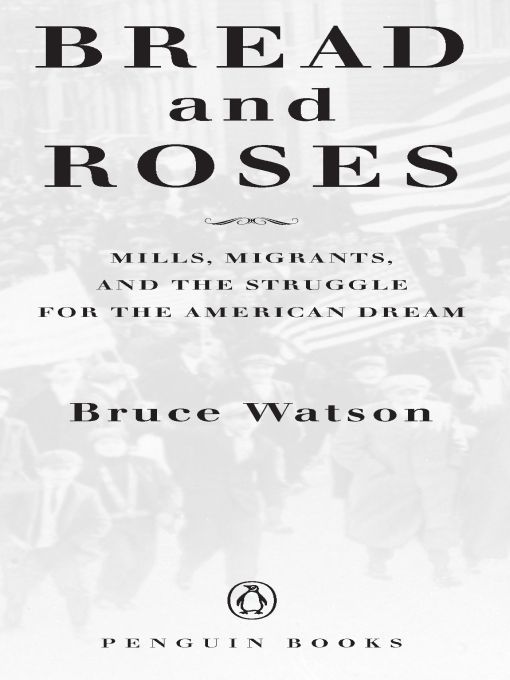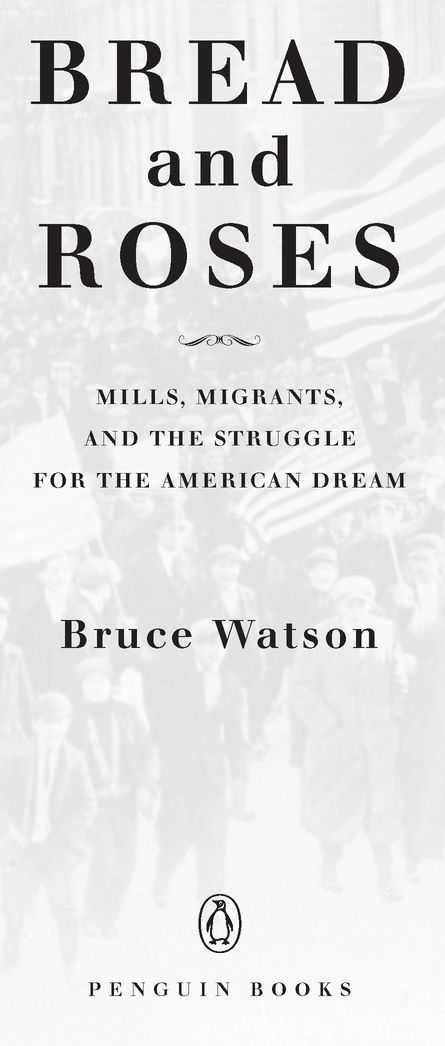Table of Contents
Praise for Bread and Roses
A spirited account.The Boston Globe
Watson dramatically and effectively brings back to life the 1912 Lawrence strike. With a keen eye for geographical and biographical detail, he captures the contours of industrial New England, re-creates the gritty neighborhoods populated by various European immigrant groups, and carefully lays out the ideological beliefs and personal circumstances of the conflicts many principal actors.... A skilled storyteller, Watson offers a moving and compelling account of radical dreams, conservative nightmares and immigrant aspirations that informed the making of modern America.
Chicago Tribune
A colorful, compelling read that goes well beyond reporting history.
Daily Hampshire Gazette (Northampton, Massachusetts)
Well sourced, evenhanded and briskly paced, Watsons account of the dramatic textile mill strike in Lawrence, Massachusetts, during the icy winter of 1912 presents a panoramic glimpse of a half-forgotten America. The story... is riveting in itself and Watson places that struggle within the larger currents of reform that were slowly reshaping America.
Publishers Weekly
A fine reconstruction of events now too little remembered.
Kirkus Reviews
A stirring but studiously balanced narrative. Watson does not inveigh in simplistic fashion; rather, he explains Lawrences mid-1800s industrial beginnings, its transformation by the immigrant influx in the two decades preceding the strike, and the economics of the industry. Also demurring from demonizing the mill owners... Watson wisely allows the strikes actors to orate, march, or stand trial through the ebb and flow of the strike. Effecting a realistic, street-level vision of the strike, Watson earns and deserves the attention of readers interested in labor and the Progressive Era.
Booklist
ABOUT THE AUTHOR
While becoming a writer, Bruce Watson worked as a bartender, a temporary typist, a factory worker, a journalist, a Peace Corps volunteer, and an elementary schoolteacher in, among other places, Lawrence, Massachusetts. He is a frequent contributor to Smithsonian Magazine and is the author of The Man Who Changed How Boys and Toys Were Made and Sacco and Vanzetti: The Men, the Murders, and the Judgement of Mankind. He lives in Massachusetts with his wife and two children.
For the billion people around the world who still survive on a dollar a day
If I did not work, these worlds would perish....
Bhagavad Gita
Introduction
During the winter of 1912, headlines from a Massachusetts mill town captivated the nation. The drama began on a bitterly cold Friday in January. Just after paychecks were passed out that morning, thousands of workers stormed out of the massive textile mills that lined the Merrimack River north of Boston. They were protesting a pay cut, but they were really on strike for their lives.
By noon that day, dozens of power looms that wove worsted wool and cotton cloth had been smashed. Thousands more were idle. Broad, expansive mill rooms that only hours before had roared with the drone of machinery were eerily silent, empty. Outside, police had responded to a riot call. Teeming crowds poured through the streets shouting Strike! in thirty languages. By the following Friday, fifteen thousand workers stood on picket lines that stretched for blocks, running all the way around some of the worlds longest buildings. Facing them were whole battalions of state militia, their bayonets fixed. On both sides of the divide, stars and stripes waved in the drifting snow.
For the next two months, Americans followed the latest dispatches from Lawrence, Massachusetts. Lawrence was embroiled in a bitter labor standoff, newspapers reported. Radicals preaching industrial revolution were stirring up uneducated immigrants in a strike that could lead to nation-wide anarchy. Rich mill owners and their hired militia were barely keeping order at bayonet point. America watched and waited. Wherever workers huddled together, from the lumber camps of Oregon to sweatshops on New Yorks Lower East Side, the talk turned to Lawrence. Workers pooled their wages and sent them to strikers. Rallies led by fiery speakers ended with coins raining down on the stage, coins for hungry families in Lawrence. Meanwhile, in the finer homes, men with trim mustaches and starched collars read about Lawrence and shuddered. Sometimes they even shared their fears with their wives. Any day now, they predicted, some radical would say something incendiary. Some fool would throw a rock. The militia would open fire and dozens would die. Any day, the name of Lawrence would become as notorious as that of Haymarket or Homestead, an inspiration for further anarchy.
But as the winter deepened and the strike dragged on, unprecedented events caused old certainties to falter. Police found dynamite stashed in the citys tenement district but soon became suspicious about its origins. Then the nations most feared radical, Big Bill Haywood, arrived in Lawrence to join the strike. Ten thousand met him at the train station and twice that many heard his thunderous voice ring out over the Lawrence Common. Later, a protest turned violent and a woman was shot. The strikes leaders were arrested for inciting her murder even though they had been a mile from the scene. And state militia came by the thousand, turning Lawrence into an armed camp.
As journalists from around the nation flocked to Lawrence, they found a surprising scenario. Workers were not in despair; they were singing. On sidewalks, women locked arms and marched together, cheering, calling out to others to join them. Reporters who journeyed into the dark maze of tenements found similar surprises. Immigrants from fifty-one countries were not at each others throats, as mill owners had hoped. Germans with Jews, Italians with Poles, Syrians with French Canadians, they were sharing food, translating speeches for each other, and creating a community rarely seen in the savage strikes that had scarred America since the 1870s. The New York Sun reported: Never before has a strike of such magnitude succeeded in uniting in one unflinching, unyielding, determined and united army so large and diverse a number of human beings. There was something different about this strike, reporters said. Their suspicions were confirmed in mid-February.
After nearly a month without work or pay, strikers tried a tactic used in Europe but never before in America. Scores of mothers dressed their children in their Sunday best, took them to the train station, bid tearful good-byes, and sent them into the custody of total strangers. In New York, the Children of Lawrence were paraded through the streets. Dirty-faced, malnourished, bewildered, they were housed by sympathetic families who gave them their first decent meals in a month and took them to the zoo, to museums, to wonders beyond their wildest dreams. The Childrens Exodus made headlines around the nation and made Lawrence police determined it would not happen again. Two weeks later, when more mothers took their children to the train station, police were waiting. What followed shocked even the most jaded observer. And still, despite congressional hearings, hunger, sporadic violence, and bedrock solidarity, the strike went on....
Through the mysterious process that propagates fable and folk song, what happened in Lawrence is now known as the Bread and Roses strike, although the slogan was probably never used during the uprising. Bread and Roses has also come to stand for labors long struggle for decent wages and the eight-hour day. Activists of all stripes use the phrase with pride, yet in the decades following the strike, pride was hard to find in Lawrence. For two full generations after that headlining winter, a curious silence prevailed throughout the city. Fearing repercussions from mill bosses, few would talk about the strike. Children grew up hearing little about it from parents or teachers. Generations passed without a single anniversary. In the 1970s, when the strikes new name surfaced, it was deeply resented. Only in the last few decades has Lawrence begun holding annual Bread and Roses festivals on its common. The first few were attended by a handful of people in their nineties who shared memories. Then these witnesses died, leaving the strike to be pieced together by children, grandchildren, and historians.



